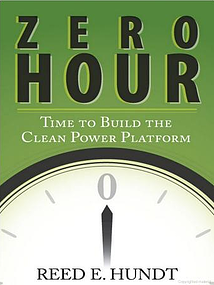 This is the fourth of five blog posts adapted from the new book “Zero Hour: Time to Build the Clean Power Platform,” by Reed E. Hundt, former chairman of the Federal Communications Commission and Board Member of the Advanced Energy Economy Institute. Read all the posts here.
This is the fourth of five blog posts adapted from the new book “Zero Hour: Time to Build the Clean Power Platform,” by Reed E. Hundt, former chairman of the Federal Communications Commission and Board Member of the Advanced Energy Economy Institute. Read all the posts here.
Buy the book: Amazon | Google | Kobo | Barnes and Noble | EbookMall
For the new power platform to leap from status quo-bound impossibility to consumer-driven inevitability, as the communications platform did, we need to avoid imposing the costs of transition on the wrong people, and present the future as it is: an opportunity, not a sacrifice. No more doom and gloom.
Utilities and regulators correctly observe that someone has to pay for the new power platform. There are always only three possible payers for anything: consumers, shareholders (investors), and taxpayers. If consumers are asked to pay more for a clean version of an identical product (electricity whether made from the sun or coal), then the market response will be skimpy. Pushing the clean energy platform on consumers is hard; encouraging consumer pull for cheap, clean energy is easy.
The utility’s shareholders, however, should not be asked to shoulder the cost burden. Pension plans, mutual funds, institutions own these shares. There’s not any good reason to make them pay for the change to the new power platform. The category of taxpayers is where the cost should be placed – if common sense and ethics can trump lobbying and ideology.
The utilities and regulators also are acutely aware that as consumers buy less energy, due to distributed generation and efficiency measures, then the utility will face declining revenues. Yet it may not be able to lower its costs. As an example, a homeowner with solar on the roof still wants to be connected to the electric grid in order to take power at night or on cloudy days. The utility has to maintain that grid connection to the homeowner without obtaining as much revenue from that customer.
This same situation was faced by the fixed line telephone companies as cellular service cannibalized their business. They decided to enter the mobile business in order to be on the right side of history.
By insisting that utilities offer cleaner, cheaper electricity, regulators will be forcing them to face a future that technological change will not permit them to avoid in any case. Without question, regulators and utilities need to reach a new compact concerning how utilities will maintain their essential transmission and distribution networks as the traditional electricity revenue declines. Revenue will fall because of efficiency gains and distributed power solutions that supplant grid-supplied electricity. Denial of this reality will be as unavailing as it would have been for AT&T to deny two decades ago that long distance was beginning to evaporate as a discrete, profitable service.
Utilities buying from regional grids also will reasonably worry about how to maintain load balances and access to adequate power during periods of high demand. They may say that even whole states are not masters of regional grids. But wide area transactive grids and more localized microgrids can link demand and supply in supple, instantaneous ways. New transmission lines also can provide more flexibility.
These measures cost money – money that should come from government. Government can borrow from bond markets, provide the up-front capital on a very long term, low interest rate note, and be paid back over the decades in which new grids, clean energy generation facilities, and efficiency measures will be used and useful. The federal government enjoys especially low rates at this time. Consumers will pay more even for cheaper, cleaner energy solutions than the cost of federal government debt.
No better time has existed for federal borrowing to pay the up-front costs of the shift to the new power platform. But in the absence of such wise federal action, states acting alone or in consortiums should issue the necessary bonds, and pay the up-front costs for the necessary changes.
In addition to a consumer bill of rights, let’s imagine changing the principles of tax policy in order to expedite the move to the new power platform. Let’s eliminate tax breaks for what should be discouraged and refrain from taxing what should be encouraged. Tax policy supports the transportation of coal (usually on railroads) and oil (usually on pipelines). Instead, we should decide not to tax clean energy generation, distribution or consumption – at least until the new power platform is built. In the salad days of the Internet, the Clinton Administration decided to minimize sales taxes on e-commerce. Amazon and others were great beneficiaries. But the largest winner was America because that new tax policy helped accelerate the move to the new knowledge platform.
Above all, we need to avoid characterizing the transition to the new power platform as something that’s painful, something that requires sacrifice. It’s shouldn’t be, and it won’t. With appropriate financing mechanisms, like green banks, government can manage the necessary costs of the transition, while consumers get to delight in their ability to get cleaner, cheaper energy and the economy gets a boost from new investment and new industries that deliver our new, cheaper, cleaner energy choices. The new power platform is not something to dread. It’s something to get excited about.
To avoid this trap, we will need to break with the cultural attitude toward energy that has pervaded the environmental movement for nearly 50 years – namely that energy is scarce and damaging, and the way to manage it is to make energy more costly.
By the 1990s and early 00s, the neo-liberal consensus among visionary industrialists, economists and environmentalists consisted of raising costs for carbon-intense producers. The stated purpose was to make non-polluting alternatives more “competitive,” but the reality would be higher energy prices for consumers. This neo-liberal consensus held as axiomatic, even if not always explicitly stated, the belief that energy is scarce, and ought to be more expensive.
The truth is the opposite: natural gas turns out to be under the feet of almost everyone. The sun can provide power for all human needs until the world ends. Energy is abundant, and ought to be cheap.
The corollary to “energy is cheap and ought to be expensive,” though rarely stated, is that consumers, who are also voters, must suffer in order to protect the next generation from climate change. This is also not true. Consumers can benefit right away from the move to the new power platform. So too can the unemployed, the underemployed, and investors. Even those who worry about the federal deficit would find that hundreds of billions of dollars of investment in the new power platform might brighten their outlook in just the same way that the unanticipated, prodigious investment in the new knowledge platform forced the deficit hawks of the Clinton Administration to be happy with the way things turned out, even though their dire predictions proved wildly wrong.
Energy scarcity as a belief and making consumers unhappy as a policy do not appeal to most people. Nevertheless, scarcity and consumer pain were the messages of the environmental movement in the critical years of 2008-09, when it tried to mobilize for a bill to address climate change.
Imagine, instead, if the thrust of the Waxman-Markey bill, and the campaigning around it, had been “cheap, clean energy for everyone” instead of “put a price on carbon.” The resulting bill could have been irresistibly appealing. It could have focused on accelerating natural gas distribution, which would have appealed to Republican states like Texas. It could have accelerated investment so as to be part of a job creation policy to offset the Great Recession. It could have offered to buy out owners of outmoded coal plants at book value. Shutting down those facilities would have created demand for Green Bank-subsidized clean fuels. The bill could have insisted that regulators in every state require utilities to offer cheaper, cleaner energy solutions to their customers.
In short, it should have been a consumer welfare bill instead of a consumer punishment bill. It could have created a universal service subsidy to assure that consumers in coal-intense states did not suffer rate shock, and to win votes from legislators in those states.
Every American is well-advised to ask, with respect to the new power platform, “What’s in it for me?” Every entrepreneur in Silicon Valley expects consumers to ask that question, and offers either of two answers: I am offering something that is faster, better, cheaper, or I am offering you a brave new world experience.
Fortunately the advocates of a rapid shift to the new power platform can provide both answers to energy consumers. Everyone can get a cheaper energy bill for cleaner electricity. In addition, numerous very cool new things thrive on the new energy platform. The best example as of this writing is the Tesla electric sedan. It is roomy, quiet, fun to drive, and gives the pleasure of avoided cost when one passes by gas stations without looking at the dashboard for a gas tank reading. Another exciting and useful service is the ability to manage conveniently, from any distance, the heating and air conditioning of one’s apartment or house. Then there is Big Belly, the solar-powered trash compactor with wireless connectivity that tell municipalities when it needs to be emptied, reducing truck trips to half-filled trash cans.
The new power platform is not a sacrifice, it is an opportunity – for consumers, for business, for the economy. What are we waiting for?
Previously: Making Consumers King
Coming next: 10 Steps Toward the New Power Platform
Over the course of 2013, AEE has held several CEO forums, co-sponsored by AEE and MIT’s Industrial Performance Center, to discuss building the 21st Century Electricity System. Click below to learn more.
